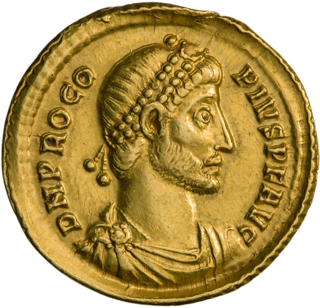
Julian was the Caesar of the West from 355 to 360 and Roman emperor from 361 to 363, as well as a notable philosopher and author in Greek. His rejection of Christianity, and his promotion of Neoplatonic Hellenism in its place, caused him to be remembered as Julian the Apostate in Christian tradition. He is sometimes referred to as Julian the Philosopher.

Year 602 (DCII) was a common year starting on Monday of the Julian calendar. The denomination 602 for this year has been used since the early medieval period, when the Anno Domini calendar era became the prevalent method in Europe for naming years.
Year 139 (CXXXIX) was a common year starting on Wednesday of the Julian calendar. At the time, in Western civilization, it was known as the Year of the Consulship of Hadrianus and Praesens. The denomination 139 for this year has been used since the early medieval period, when the Anno Domini calendar era became the prevalent method in Europe for naming years.
The 360s decade ran from January 1, 360, to December 31, 369.
Year 499 (CDXCIX) was a common year starting on Friday of the Julian calendar. At the time, it was known as the Year of the Consulship of Iohannes without colleague. The denomination 499 for this year has been used since the early medieval period, when the Anno Domini calendar era became the prevalent method in Europe for naming years.

Year 461 (CDLXI) was a common year starting on Sunday of the Julian calendar. At the time, it was known as the Year of the Consulship of Severinus and Dagalaiphus. The denomination 461 for this year has been used since the early medieval period, when the Anno Domini calendar era became the prevalent method in Europe for naming years.

Year 995 (CMXCV) was a common year starting on Tuesday of the Julian calendar.

Year 906 (CMVI) was a common year starting on Wednesday of the Julian calendar.

Procopius was a Roman usurper against Valens.

The Battle of Ctesiphon took place on 29 May 363 between the armies of Roman Emperor Julian and an army of the Sasanian Empire outside the walls of the Persian capital Ctesiphon. The battle was at first an initial Roman victory, but eventually the Roman forces found themselves unable to continue their campaign as they were too far from their supply lines.

Assyria was a short-lived Roman province in Mesopotamia that was created by Trajan in 116 during his campaign against the Parthian Empire. After Trajan's death, the newly proclaimed emperor Hadrian ordered the evacuation of Assyria in 118.

The Battle of Samarra took place in June 363, during the invasion of the Sasanian Empire by the Roman emperor Julian. After marching his army to the gates of Ctesiphon and failing to take the city, Julian, realizing his army was low on provisions and in enemy territory started marching towards Samarra.
Flavius Arintheus was a Roman army officer who started his career in the middle ranks and rose to senior political and military positions. He served the emperors Constantius II, Julian, Jovian and Valens. In 372 he was appointed consul, alongside Domitius Modestus.
Victor was a Roman military officer and politician, who served the emperors Constantius II, Julian, Jovian and Valens. He was appointed consul in AD 369, alongside Valentinianus Galates.

Julian's Persian expedition began in March 363 AD and was the final military campaign of the Roman emperor Julian. The Romans fought against the Sasanian Empire, ruled at the time by Shapur II.
The Peace Treaty of 363 between the Eastern Roman Empire and the Sasanian Empire was the subsequent treaty from Emperor Julian's Persian expedition. Upon Julian's death, the newly elected Emperor Jovian was forced into signing a humiliating treaty by which territorial and diplomatic concessions were given to the Sasanians.
During the siege of Maiozamalcha, 363 CE, the Roman army under Emperor Julian stormed, pillaged, and destroyed the city of Maiozamalcha, before continuing onward to the Sasanian capital of Ctesiphon.

The Battle of Maranga occurred in 363, shortly after the Battle of Ctesiphon. The Romans repelled a Sasanian attack while sustaining minimal losses. However, the army's lack of supplies continued to threaten the army, and soon afterwards the emperor Julian was killed at the Battle of Samarra.
Surena was a 4th-century Iranian military officer active during the reign of the Sasanian king (shah) Shapur II. He played an important role in the denial of the Roman invasion in 363 and the peace negotiations that followed.
The 363 Arsakawan earthquake took place c. 363. It affected the cities of Arsakawan and Salat.











